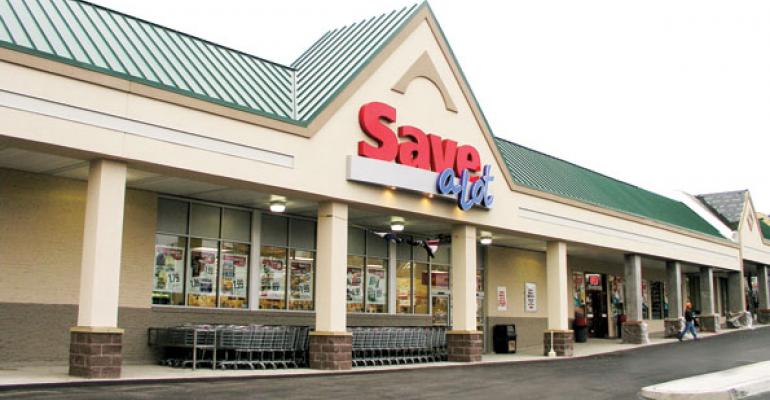ST. LOUIS — The troubles at Supervalu are bleeding into the performance of its discount Save-A-Lot division, according to licensees who say higher costs and a lack of leadership at the parent company have contributed to sales declines mirroring that of Supervalu’s conventional chains.
Licensees added that they were hopeful that Supervalu’s review of strategic alternatives, announced earlier this month, would ultimately result in the chain winding up in a more supportive ownership environment — perhaps as a member-owned cooperative — but acknowledged things could get worse in the meantime with news that Tom Lenkevich, Save-A-Lot’s chief operating officer, would resign from the company later this summer.
Lenkevich, a former Save-A-Lot licensee who has been responsible for retail operations at the limited-assortment banner, was perceived by many licensees as their last ally at corporate headquarters. As of the end of the last fiscal year, 937 of Save-A-Lot’s 1,332 stores were owned by licensees.
More Supervalu news: COO Lenkevich to Depart Safe-A-Lot
A Save-A-Lot spokeswoman last week confirmed Lenkevich was seeking other career opportunities. It was unclear last week whether a successor would be named.
“I’m extremely disappointed that Tom Lenkevich is leaving as COO,” one Save-A-Lot licensee, who asked not to be identified, told SN last week. “He has tremendous ability and having been a licensee at one point, he knows the direction that Save-A-Lot has been heading in.”
 Industry sources last week said Lenkovich’s departure could widen a gap between licensed Save-A-Lot store owners and its management team, headed since last May by former Wal-Mart executive Santiago Roces. Roces, a former colleague of Supervalu’s chief executive officer, Craig Herkert (pictured), succeeded longtime Supervalu employee Bill Shaner at the head of Save-A-Lot, which is based in St. Louis.
Industry sources last week said Lenkovich’s departure could widen a gap between licensed Save-A-Lot store owners and its management team, headed since last May by former Wal-Mart executive Santiago Roces. Roces, a former colleague of Supervalu’s chief executive officer, Craig Herkert (pictured), succeeded longtime Supervalu employee Bill Shaner at the head of Save-A-Lot, which is based in St. Louis.
“Since making the decision to go to the current presidency of Save-A-Lot, it never got off to a good start and it hasn’t gotten any better,” Jose Tamez, an executive recruiter with Austin-Michaels, Denver, told SN last week. “With the announcement of Tom Lenkevich leaving, it will probably just deepen the trough between the licensees and management of Save-A-Lot.”
According to Tamez, Roces’ international experience — he led Wal-Mart divisions in Argentina and South Korea and began his retailing career working for Carrefour in Spain — made a poor match with Save-A-Lot’s licensees, many of whom are small-town U.S. independent retailers. “There was a fundamental gap from the beginning,” Tamez said. “And I’m not blaming the current president for that. His experience is what it is. Frankly, it was a faulty hire from the start.”
Lack of Confidence Among Licensees
“I’d say the licensees as a group had a lot of confidence in Tom [Lenkevich],” a licensee told SN. “I don’t know if they have the same confidence in Santiago. I’d say they don’t. And they certainly don’t have any more confidence in him than they do in Craig Herkert. He doesn’t understand what Save-A-Lot is about, or at least he hasn’t shown it.”
In financial results posted earlier this month, Minneapolis-based Supervalu said Save-A-Lot posted flat sales in the first quarter that ended June 16, despite operating 53 more stores than the year before. Identical-store sales fell by 3.4% and operating earnings of $59 million, or 4.6% of sales, were down by 14.5% from the same period in 2010, when profit as a percent of sales totaled 5.4%. The company said declining ID sales and higher costs related to its growth strategy led to the decline in profitability.
More Supervalu news: Elicits Strong Reader Reaction
In a conference call this month, Herkert attributed Save-A-Lot’s weakening sales to a stressed core customer base and increased competition, but also acknowledged there were “executional opportunities” related to “being as responsive as we need to be to consumer demands.”
Licensees say prices are too high. Jimmie Gipson, chief executive officer of Houchens Industries, Save-A-Lot’s largest licensee with 220 stores, told SN last week that sales and profitability are down as a result of less competitive pricing sparked by higher costs.
More Supervalu news: Eyes Potential Sale, Slashes Spending to Cut Prices
“My opinion is that the cost structure got away from [Supervalu],” Gipson said. “It takes an awfully good wholesaler to contain their costs because it’s so easy to pass those costs on to the retailer. And very few wholesalers have the discipline to hold costs down.”
Another Save-A-Lot operator said cost pressures have increased along with the struggles of Supervalu’s conventional banners. Last year, the retailer scaled back plans to grow Save-A-Lot to devote more resources to its ailing conventional banners.
“Supervalu as a whole has bounced around in their priorities,” the licensee said. “When Herkert first came to Supervalu he said they were going to concentrate on price and expanding the store base. They spent the money expanding the store base without addressing price, not only at Save-A-Lot, but at the chains: Acme, Shaw’s and Jewel. And that affects Save-A-Lot because as those chains falter, [Supervalu] was more dependent on money coming in from Save-A-Lot. It’s gotten where the cart is before the horse.”
Licensee: Growth Strategy Flawed
The same licensee opined that Save-A-Lot’s growth strategy — Herkert made Save-A-Lot store expansion a central part of his plans for Supervalu, saying he aimed to double Save-A-Lot’s store base by 2015 — attracted some retailers who were lured more by incentives than an understanding of the limited-assortment concept.
Financial analysts have said that selling Save-A-Lot could be central to Supervalu’s survival, although declining financial results could prevent the company from getting the price it might want.
Gipson said a sale of the retailer “could be an opportunity, but it could also be something that’s negative. I think the water will be muddier before it gets clearer.”
More Supervalu news: Supervalu Shareholder Threatens Class Action
He said he felt that a member-owned cooperative would be the “most advantageous” ownership structure for Save-A-Lot, but acknowledged he did not know of any effort to effect one, which would require a heavy financial outlay for members. But any new owner, Gipson said, would have the same challenge.
“I think if someone could get the cost structure in line, the Save-A-Lot model has an opportunity to be revived,” he said.
“I have complete faith in the Save-A-Lot program as a whole,” the other licensee added. “I think Save-A-Lot will survive all this. There is a lot of confidence in the concept, but the confidence in the leadership is questionable.”
| Suggested Categories | More from Supermarketnews |
 |
|
|
|
|

|
|


